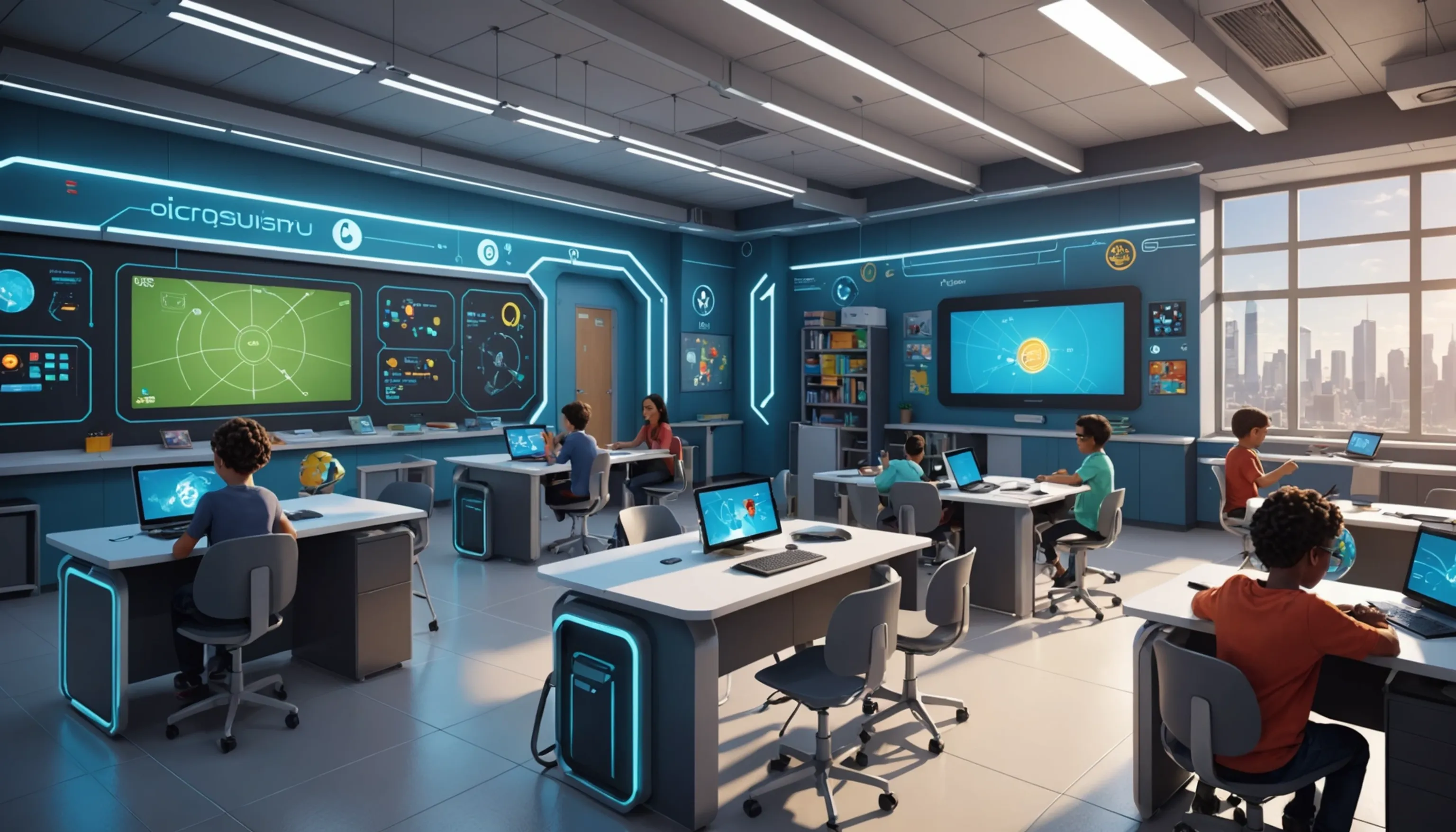STEM Learning Will Become a Game, as Elon Musk Predicted
 HvWHenry van Wagenberg
HvWHenry van Wagenberg
Elon Musk's Vision for STEM Learning as a Game
Elon Musk envisions a future where STEM learning becomes an engaging game, transforming the way students approach subjects like science, technology, engineering, and mathematics. By integrating game mechanics into education, Musk believes that students will be more motivated to learn and explore these crucial fields. This approach not only makes learning enjoyable but also fosters critical thinking and problem-solving skills essential for success in today's world. As technology evolves, the potential for gamifiedSTEM education to capture the interest of teenagers becomes increasingly promising, paving the way for innovative learning experiences.
Understanding STEM Education
STEM education refers to the integrated teaching of science, technology, engineering, and mathematics. This approach aims to equip students with the essential skills needed to thrive in a rapidly evolving job market. Unlike traditional education that often compartmentalizes these subjects, STEM education encourages students to make connections between disciplines, fostering a more comprehensive understanding of how they interact in real-world applications.
One key aspect of STEM education is its focus on hands-on learning. By engaging students in practical experiments, projects, and problem-solving activities, they can apply theoretical concepts in tangible ways. This experiential learning process not only enhances comprehension but also cultivates critical thinking and creativity.
Furthermore, STEM education emphasizes collaboration, as many challenges in these fields require teamwork to solve. Students learn to communicate effectively, share ideas, and work towards common goals, which are vital skills in both academic and professional settings.
As we move further into the 21st century, the demand for individuals with strong STEM skills continues to rise. Careers in technology, engineering, and data analysis are increasingly prevalent, making it essential for today’s teens to develop these competencies. By embracing STEM education, we prepare them for a future where innovation and problem-solving will be at the forefront of various industries.

The Importance of STEM Skills for Teens
In today's rapidly changing world, the importance of STEM skills for teenagers cannot be overstated. As technology continues to advance at an unprecedented rate, proficiency in science, technology, engineering, and mathematics has become crucial for success in various fields. These skills not only open doors to lucrative career opportunities but also empower teens to navigate the complexities of modern life.
One significant reason for prioritizing STEM skills is the increasing demand for professionals in technology-driven industries. Fields such as software development, engineering, and data analysis are projected to grow significantly in the coming years. By acquiring strong STEM skills, teens position themselves favorably in the job market, enhancing their employability and potential income.
Moreover, STEM education fosters critical thinking, problem-solving, and analytical abilities. These skills are essential for tackling real-world challenges, from environmental issues to technological advancements. As teenagers engage in STEM activities, they learn to approach problems methodically, evaluate evidence, and make informed decisions.
Additionally, STEM skills promote creativity and innovation. The ability to think outside the box and develop novel solutions is vital in today's competitive landscape. Encouraging teens to explore STEM fields cultivates a mindset of curiosity and resilience, preparing them to adapt to future changes.
In summary, equipping teenagers with STEM skills is essential for their personal and professional growth. By embracing these competencies, they can thrive in a world that increasingly values innovation and technological proficiency.
How Gamification Can Enhance STEM Learning
Gamification integrates game elements into non-game contexts, and it can significantly enhance STEM learning by making the educational process more engaging and interactive. By incorporating challenges, rewards, and competitive elements, students are motivated to participate actively in their learning journey. Gamified STEM activities can improve retention of complex concepts, as students are more likely to remember information they encountered during enjoyable experiences. Additionally, this approach fosters critical thinking and problem-solving skills, as students navigate through challenges and find solutions in a fun environment. Ultimately, gamification can transform STEM education into a more captivating and effective learning experience.

Benefits of Game-Based Learning in STEM
Game-based learning in STEM education offers numerous benefits that significantly enhance the learning experience for students. One of the primary advantages is increased engagement. When students participate in game-based activities, they often feel more motivated and invested in their learning. This heightened interest leads to deeper exploration of STEM concepts and a greater willingness to tackle complex problems.
Another benefit is the development of critical thinking and problem-solving skills. Many educational games are designed to present challenges that require players to analyze situations, develop strategies, and make decisions. This active learning process helps students build essential skills that are vital for success in both academic and real-world contexts.
Furthermore, game-based learning promotes collaboration among students. Many games require teamwork, encouraging communication and cooperation as students work together to achieve common goals. This collaborative environment enhances social skills and prepares teens for future workplaces, where teamwork is often essential.
Additionally, game-based learning provides immediate feedback. Students can see the results of their actions and decisions in real time, allowing them to adjust their strategies and improve their understanding of concepts. This instant feedback loop helps reinforce learning and encourages students to persist through challenges.
In conclusion, the integration of game-based learning in STEM education not only makes learning more enjoyable but also equips students with the skills necessary to thrive in a technology-driven world. By embracing this innovative approach, educators can create a more dynamic and effective learning environment.
Examples of STEM Games and Tools
There are numerous STEM games and tools available that effectively engage students while promoting critical thinking and problem-solving skills. These resources span various formats, from board games to digital applications, ensuring that there's something for every learning style.
One popular example is Code.org, an online platform that teaches coding through interactive games and challenges. Students can learn programming languages while navigating through fun puzzles and mazes, making the learning process enjoyable and accessible.
Another excellent tool is LEGO Mindstorms, which combines the creativity of building with robotics. Students can design, build, and program their own robots, fostering both engineering skills and computational thinking. This hands-on approach encourages experimentation and innovation.
The game Kerbal Space Program offers a unique opportunity for students to explore physics and aerodynamics by designing and launching their own spacecraft. Players must apply concepts of gravity, thrust, and orbital mechanics to succeed, making it a captivating way to learn about space exploration.
Additionally, platforms like Kahoot! and Quizizz provide interactive quiz-based learning experiences that can be tailored to various STEM topics. These tools allow teachers to create engaging assessments that promote friendly competition and immediate feedback among students.
In summary, incorporating diverse STEM games and tools into the curriculum can significantly enhance students' learning experiences, making complex concepts more relatable and enjoyable.
The Future of STEM Education According to Elon Musk
Elon Musk envisions a future where STEM education is transformed through innovation and accessibility. He believes that learning should be engaging and interactive, utilizing technology to create immersive experiences. Musk advocates for a curriculum that emphasizes problem-solving and real-world applications, preparing students for the challenges of tomorrow. By integrating gamification and advanced tools, he envisions a system that not only teaches fundamental concepts but also inspires creativity and critical thinking. Ultimately, Musk’s vision for STEM education aims to cultivate a generation of innovators ready to tackle global issues and drive technological advancement.
Innovations in Education Technology
Innovations in education technology are transforming the landscape of learning, particularly in the realm of STEM education. These advancements not only enhance the way students engage with subjects but also prepare them for a rapidly evolving job market. One significant innovation is the use of augmented reality (AR) and virtual reality (VR) tools, which allow students to immerse themselves in interactive learning environments. For example, VR platforms can simulate scientific experiments or historical events, offering students hands-on experiences that would otherwise be impossible.
Another noteworthy development is the rise of online learning platforms, such as Khan Academy and Coursera. These resources provide students with access to a wealth of information and courses at their fingertips, enabling personalized learning experiences. Students can progress at their own pace, revisiting challenging concepts or exploring new topics that pique their interest.
Artificial intelligence (AI) is also making strides in education technology. AI-driven tools can analyze students’ learning patterns and offer tailored recommendations, helping educators identify areas where individual students may need additional support. This data-driven approach allows for a more customized learning experience, ensuring that students receive the guidance they need to succeed.
Furthermore, collaboration tools, such as Google Classroom and Microsoft Teams, facilitate communication and teamwork among students, fostering a sense of community even in remote learning environments. These innovations are not only making STEM education more engaging but also equipping students with the skills necessary for success in an increasingly digital world.
Preparing Teens for a STEM-Focused Future
Preparing teens for a STEM-focused future is essential in today’s technology-driven world. As industries increasingly rely on science, technology, engineering, and mathematics, equipping young minds with the necessary skills is crucial. Here are several strategies to effectively prepare them:
- Encourage Early Exposure: Introduce teens to STEM concepts at an early age through engaging activities such as science fairs, coding camps, and robotics clubs. The earlier they start, the more comfortable they will become with these subjects.
- Integrate Real-World Applications: Demonstrate how STEM skills apply to real-life scenarios. Organize field trips to tech companies, laboratories, or engineering firms, allowing students to see professionals in action.
- Promote Critical Thinking: Encourage teens to tackle problems creatively. Use project-based learning to help them develop analytical skills by working on challenges that require innovative solutions.
- Utilize Technology: Leverage educational technology tools and platforms that offer interactive learning experiences. Games, simulations, and online courses can enhance their understanding of complex concepts.
- Foster Collaboration: Create opportunities for teamwork through group projects and competitions. Working collaboratively helps students build communication skills and learn from one another.
In conclusion, by implementing these strategies, educators and parents can prepare teens for a STEM-focused future, ensuring they are equipped to thrive in a world that increasingly values innovation and technological proficiency.
